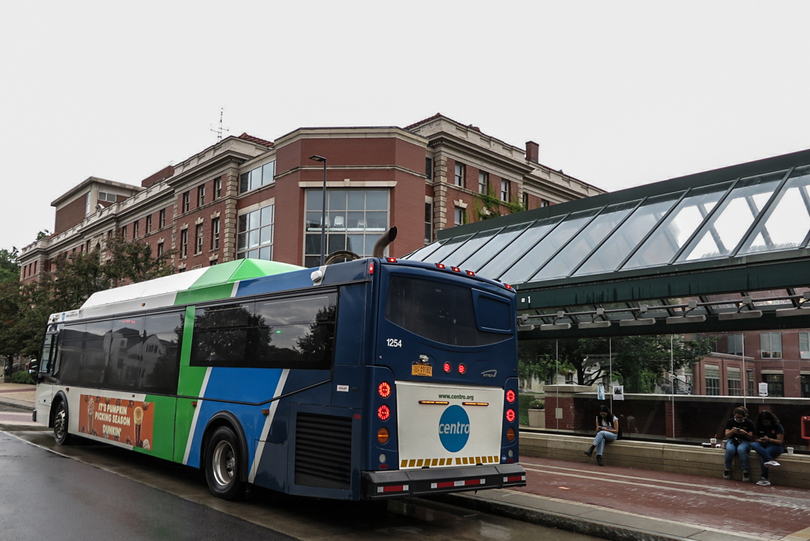Students mistrust SU transportation services after Centro reduces schedule

Lucille Messineo-Witt | Photo Editor
Students have concerns after Centro announced that they will no longer provide transportation services on Syracuse University's campus after 8 p.m.
Get the latest Syracuse news delivered right to your inbox.
Subscribe to our newsletter here.
One Friday evening, Cooper Dawson waited about 40 minutes at a South Campus bus stop for a Centro bus so he could visit a friend on Euclid Avenue. He recalls about 20 other students waiting at the same stop before they all boarded the crowded bus together.
Dawson, a junior international relations major, isn’t the only Syracuse University student who’s noticed delayed and overcrowded Centro buses this semester. Since the agency reduced its on-campus routes last week, many South Campus residents worry about having reliable transportation from their apartments to Main Campus.
Centro announced Sept. 13 that it would no longer provide transportation services on SU’s campus past 8 p.m. due to staff shortages. Although the Centro schedule between 6 a.m. to 8 p.m. remains unchanged, the university told students who take Centro buses to expect increased delays.
SU’s trolleys replaced the routes that Centro buses used to run past 8 p.m., running approximately once every 15 minutes from 7:30 p.m. to 3 a.m. SU is awaiting the delivery of three additional trolleys and will soon hire more drivers, said Jennifer Horvath, communications director for business, finance and administrative services at SU.
A trolley taking students to Wegmans and Target will also run this Saturday after SU’s Student Association passed a bill to purchase the trolley for the day and three other days during the semester.
Despite these efforts, some students worry that the trolleys might not be a suitable replacement for the buses.
“I’ve heard about people who have classes until 9 p.m. I can imagine if things are running behind or there aren’t enough trolleys, not only are you getting out late, but you might have to sit there and wait even longer to get back to your apartment,” Dawson said.
Rubin Parker, a junior film major, is one of these students. He has a photography lab on Wednesdays that doesn’t end until after 9 p.m.
Parker said the trolleys are more crowded, which he worries pose an increased risk for the spread of COVID-19.
“The trolleys are just new. (Students) don’t entirely understand them,” said Patrick Fox, a junior international relations major, who lives on South Campus.

Fox also said the change in schedule has made the Centro buses less reliable. He’s had to figure out alternative ways of getting to Main Campus and back in the event that a bus won’t arrive in time.
“I’ve had to leave for everything considerably earlier, less out of necessity, more out of distrust,” Fox said.
I’ve had to leave for everything considerably earlier, less out of necessity, more out of distrustPatrick Fox, SU junior
Fox’s class and activity schedule has also made it so he’s often on campus past 8 p.m. While he has a friend with a car, Fox doesn’t like to ask for rides unless it’s an emergency, especially since his friend likes to go to bed early.
Some students have cars with them on campus but prefer not to drive between Main Campus and South Campus every day.
Olivia Porter, a junior majoring in political philosophy, drives from South Campus to Main Campus whenever she can. She said finding parking makes getting to class on time difficult, especially if she needs to pay for a spot.
In response to Centro reducing its services, SU announced that students with a valid permit will be allowed to use any Orange parking lot after 4:30 p.m. and on weekends, except during Carrier Dome events such as games.
Porter has classes that end as late as 6:30 p.m., and she usually likes to get dinner with friends on campus afterwards. She also likes to study in the library sometimes after her later classes. In these instances, she said her most reliable form of transportation back to South Campus is to drive herself or take a ride-hailing service.
SU also suggested its shuttle escort service as an alternative mode of late-night transportation. Fox worries about the reliability of these shuttles because he once called for one past midnight and they said they couldn’t get him for another hour.
Despite their concerns, some students feel that SU is doing the best they can to account for the inconvenience, which is outside of its control. Centro bus drivers who work on-campus routes are employed through Centro, not the university, Horvath said.
The bus driver shortage that Centro is experiencing is not unique to Syracuse but rather a nationwide issue due to the pandemic, said Josh Kaufman, a senior civil engineering major.
Centro right now needs to hire 35 to 40 new drivers. Training a driver takes at least six weeks, said Kaufman, who’s worked at two large transit agencies downstate. In New York state, bus drivers need a commercial drivers license, which requires several weeks of additional training.
“While (Centro) has made it clear that they want to be providing as good a service as possible, the odds are stacked against them,” Kaufman said.
Kaufman also works closely with SU’s Parking and Transportation Services to design routes for students traveling to the city for volunteer opportunities through the Shaw Center. He said the office is doing its best to ensure adequate transportation options for students.
“(Parking and Transportation Services) really are trying hard to make sure the university can still operate within the limits of the Centro service reductions,” Kaufman said.
Dawson said he appreciates SU providing alternative transportation to account for the reduced Centro hours and thinks increasing the number of trolleys to replace the evening Centro routes should help the problem.
“If they (SU) stick with their word, I don’t see too much of an issue,” Dawson said.




